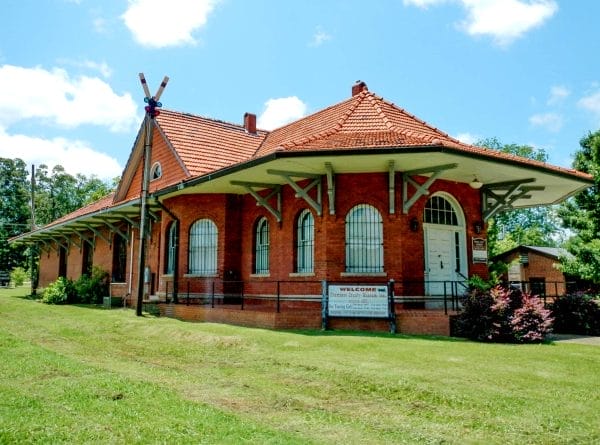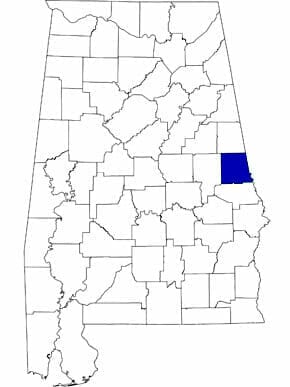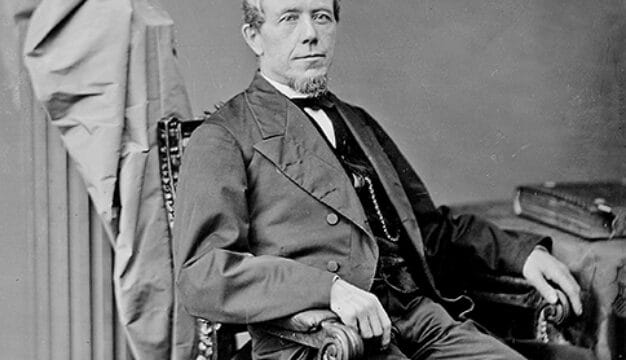Chambers County
 Joe Louis Statue in LaFayette
Chambers County lies in the east-central part of the state. It was a center of the textile industry during the early nineteenth and twentieth centuries, being home to manufacturing giant WestPoint Stevens, which traces its origins to two Confederate veteran brothers in West Point, Georgia. The county is also the birthplace of boxer Joe Louis and legendary lawman Pat Garrett. The county is governed by an elected six-member commission.
Joe Louis Statue in LaFayette
Chambers County lies in the east-central part of the state. It was a center of the textile industry during the early nineteenth and twentieth centuries, being home to manufacturing giant WestPoint Stevens, which traces its origins to two Confederate veteran brothers in West Point, Georgia. The county is also the birthplace of boxer Joe Louis and legendary lawman Pat Garrett. The county is governed by an elected six-member commission.
- Founding Date: December 18, 1832
- Area: 596 square miles
- Population: 33,427 (2020 Census estimate)
- Major Waterways: Tallapoosa River, Chattahoochee River
- Major Highways: I-85, U.S. 431, U.S. 29
- County Seat: LaFayette
- Largest City: Valley
History
 Chambers County Courthouse
Chambers County was created by an act of the Alabama State Legislature on December 18, 1832, from former Creek Indian territory ceded to the United States during the 1832 Treaty of Cusseta. The county is named for Senator Henry H. Chambers, who served in the 1819 Alabama constitutional convention.
Chambers County Courthouse
Chambers County was created by an act of the Alabama State Legislature on December 18, 1832, from former Creek Indian territory ceded to the United States during the 1832 Treaty of Cusseta. The county is named for Senator Henry H. Chambers, who served in the 1819 Alabama constitutional convention.
Chambers County, like many areas in Alabama before the Civil War, prospered as a cotton-growing area. In 1851, the area received an economic boost with the arrival of the Montgomery and West Point Railroad near the town of Cusseta. During the Civil War, the Confederacy constructed Fort Tyler in Chambers County to protect the railroad bridge, wagon bridge, and Confederate supplies in the city of West Point, Georgia, just over the county line. U.S. Army troops seized the fort and destroyed the railroad during the Battle of West Point, one of the last battles of the war.
The region suffered economic recession after the Civil War but was revitalized when local businessmen and planters established two textile mills in 1866. In August of that year, James McClendon of West Point formed the Chattahoochee Manufacturing Company, and George Huguley of Chambers County founded the Alabama and Georgia Manufacturing Company. Both mills began production in 1869 using water power from the Chattahoochee River but were forced to close temporarily during the Panic of 1873. In 1880 the Chattahoochee Manufacturing Company was reorganized into West Point Manufacturing, and the mill operated by the company was renamed Langdale Mill for its president Thomas Lang. West Point Manufacturing acquired the Alabama and Georgia Manufacturing Company in 1921. As West Point prospered, three other mills were added at Fairfax, Riverdale, and Lannet. All four mills were set in company-owned towns that provided workers and their families with schools, housing, recreational facilities, and other amenities. Eventually the four mills became known as “the Valley” and in 1980, citizens from three of the four towns (Lanett became an incorporated town in 1895) came together to build a new town named Valley, which is currently the largest population center in the county.
Major Cities and Demographics
 Chambers County Museum
According to 2020 Census estimates, Chambers County recorded a population of 33,427. Approximately 56.9 percent of respondents identified themselves as white, 40.0 percent as African American, 2.5 percent as Hispanic, 1.1 percent as Asian, 1.0 percent as two or more races, and 0.2 as Native American. The county seat, LaFayette, had a population of 2,922. Other significant population centers in the county are Valley, Five Points, and Lanett. The median household income was $43,875, as compared with $52,035 for the state as a whole, and the per capita income was $24,088, as compared with $28,934 for the state as a whole.
Chambers County Museum
According to 2020 Census estimates, Chambers County recorded a population of 33,427. Approximately 56.9 percent of respondents identified themselves as white, 40.0 percent as African American, 2.5 percent as Hispanic, 1.1 percent as Asian, 1.0 percent as two or more races, and 0.2 as Native American. The county seat, LaFayette, had a population of 2,922. Other significant population centers in the county are Valley, Five Points, and Lanett. The median household income was $43,875, as compared with $52,035 for the state as a whole, and the per capita income was $24,088, as compared with $28,934 for the state as a whole.
Economy
 Langdale Mills Powerhouse
Since its formation, Chambers County’s economy has been linked to cotton, both agriculturally and industrially. Prior to the Civil War, the area was an agricultural community dependent upon cotton, and afterward it was devoted to the textile industry. The Chattahoochee Manufacturing Company and the Alabama and Georgia Manufacturing Company were founded in 1866, and in 1880 the Chattahoochee Manufacturing Company was reorganized into West Point Manufacturing and the mill was renamed Langdale Mills and became the hub of a company town. The company opened mill villages at Fairfax and Lanett and in 1921 acquired Alabama and Georgia Manufacturing, which had been renamed Riverdale Mill. The prosperous mills produced towels and cotton duck, a heavy material used to make canvas. In 1965 stock in West Point manufacturing became publicly traded on the New York Stock Exchange. That same year the company merged with Pepperell Manufacturing of Maine and in 1988 acquired J.P. Stevens Inc. From 1880 to 1990 the company operated under one family, the Laniers. In 1993 the company changed its name to WestPoint Stevens. Today the company is the leading manufacturer of bed and bath linens.
Langdale Mills Powerhouse
Since its formation, Chambers County’s economy has been linked to cotton, both agriculturally and industrially. Prior to the Civil War, the area was an agricultural community dependent upon cotton, and afterward it was devoted to the textile industry. The Chattahoochee Manufacturing Company and the Alabama and Georgia Manufacturing Company were founded in 1866, and in 1880 the Chattahoochee Manufacturing Company was reorganized into West Point Manufacturing and the mill was renamed Langdale Mills and became the hub of a company town. The company opened mill villages at Fairfax and Lanett and in 1921 acquired Alabama and Georgia Manufacturing, which had been renamed Riverdale Mill. The prosperous mills produced towels and cotton duck, a heavy material used to make canvas. In 1965 stock in West Point manufacturing became publicly traded on the New York Stock Exchange. That same year the company merged with Pepperell Manufacturing of Maine and in 1988 acquired J.P. Stevens Inc. From 1880 to 1990 the company operated under one family, the Laniers. In 1993 the company changed its name to WestPoint Stevens. Today the company is the leading manufacturer of bed and bath linens.
Employment
According to 2020 Census estimates, the workforce in Chambers County was divided among the following industrial categories:
- Manufacturing (30.4 percent)
- Educational services, and health care and social assistance (18.2 percent)
- Retail trade (8.7 percent)
- Professional, scientific, management, administrative and waste management services (7.8 percent)
- Arts, entertainment, and recreation, and accommodation and food services (6.6 percent)
- Transportation and warehousing, and utilities (5.3 percent)
- Finance and insurance, and real estate, rental, and leasing (4.3 percent)
- Public administration (4.3 percent)
- Construction (4.2 percent)
- Other services, except public administration (3.7 percent)
- Agriculture, forestry, fishing and hunting, and extractive (2.3 percent)
- Information (2.2 percent)
- Wholesale trade (2.0 percent)
Education
The Chambers County School System oversees 16 schools, and the Lanett City School system oversees two schools. In addition, the county contains three private schools.
Geography
 Chambers County Map
Comprising approximately 596 square miles, Chambers County lies in the east-central part of the state, wholly within the Piedmont physiographic section of the state. It is bounded to the north by Randolph County, to the west by Tallapoosa County, to the south by Lee County, and to the east by Troup and Harris counties in Georgia.
Chambers County Map
Comprising approximately 596 square miles, Chambers County lies in the east-central part of the state, wholly within the Piedmont physiographic section of the state. It is bounded to the north by Randolph County, to the west by Tallapoosa County, to the south by Lee County, and to the east by Troup and Harris counties in Georgia.
The Tallapoosa River runs along the northwestern corner of the county, and numerous creeks, such as the Chikasonoxee, Allen, Chatahospee, and Osanippa, intersect the area. In addition, the Chattahoochee River runs along the eastern border of the county. Interstate 85 is Chambers County’s major transportation route, running northeast-southwest in the far eastern corner of the county. U.S. 29 and 431 are the county’s other major transportation arteries. Lanett Municipal Airport and Valley airport are the county’s public airports.
Events and Places of Interest
Chambers County’s many waterways, including the Chattahoochee and Tallapoosa rivers, are ideal for boating, fishing, and canoeing. In addition, West Point Lake, the second largest man-made lake in the U.S., provides fishing, boating, hunting, camping, and swimming. The county’s textile mill towns of Fairfax, Langdale, Riverview, and Shawmut are listed on the National Register of Historic Places and provide a glimpse of life in a company town during the late nineteenth and early twentieth centuries.
Further Reading
- Heritage of Chambers County, Alabama. Clanton, Ala.: Heritage Publishing Consultants, Inc., 1998.



